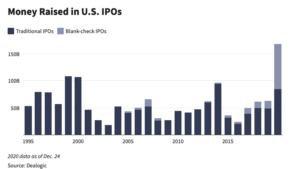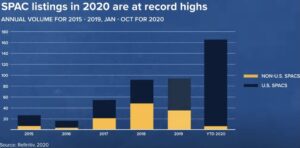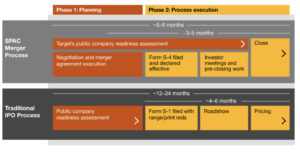Newsroom
Back in SPACs
During the last two years, investors and financial institutions have experienced a global pandemic that has seen equity markets crash, interest rates further decrease and corporate dividends slashed. The result of these market conditions has drawn investors back towards the SPAC phenomena as they have sought to identify lucrative opportunities away from traditional asset classes.
The SPAC, or Special Purpose Acquisition Company, has been in existence since the 1990s and is defined as a company with no commercial operations that is formed strictly to raise capital through an IPO with the goal of merging or acquiring private limited companies. As we enter an increasingly inflationary moment post-pandemic, however (particularly in the post-turbo-charged stimulus phase of “Bidenomics” in the US, where inflation is a clear and present danger), the lure of financing in a low interest rate environment is bound to be challenged as interest rates tick up in a monetary policy effort to ward off inflation.
The increasing capital entering SPACs alongside high-profile acquisitions has had the effect of bringing SPACs closer to mainstream financial services than arguably ever before. This has increased the optionality for firms wishing to raise funds in the market, producing some highly interesting tie-ups which, it could be argued, would have been less likely to occur under a traditional IPO format. In 2020, SPACs successfully raised a record $82.1 billion in the US (as of 24 December 2020), more than 25 times the $3.2 billion raised in 2016 and six times more than in 2019, according to data from Dealogic.
By the end of 2020, the most successful SPACs achieved some startling results with the top 5 achieving share performance returns, as per end-2020 (source: FactSet) of anything from 97% (dMY Technology Group), 110% (Longview Acquisition Corp), 154% (TPG Pace Beneficial Finance), 162% (Kensington Capital Acquisition) and 171% (Live Oak Acquisition Corp). In terms of industry type, the most successful SPACs up to the end of 2020 covered deals in some innovative sectors. Live Oak Acquisition Corp’s 171% return included a business combination with biopolymer manufacturer Danimer Scientific subsequent to Live Oak’s IPO in May 2020. Kensington Capital Acquisition’s 162% performance followed its IPO in June 2020 and subsequent deal with next-gen battery company Quantumscape in September 2020. TPG Pace priced an IPO in October and did a combination with EVBox Group, provider of EV charging technologies, in early December 2020, and saw a 154% performance until end-December 2020. The Longview Acquisition Corp SPAC’s IPO was announced in July 2020 with a view to healthcare investment. In November 2020 Longview effected a business combination with with digital health company Butterfly Network in late November 2020, and saw performance of 110% from that point until end-December 2020.
The hype surrounding SPACs has gone so far as to attract notable sponsors such as Bill Ackman’s Pershing Square Tontine Holdings Ltd which raised $4 billion in an initial public offering, plus a $1 billion commitment from Pershing Square1. Moreover, ex-Facebook executive Chamath Palihapitiya’s Social Capital raised c. $3.7 billion and later purchased Virgin Galactic in a landmark transaction valued at $4 billion. The back story to the Virgin Galactic SPAC funding is interesting. Virgin Head Richard Branson had pulled out of a promised $1 billion (plus a potential further $480 million) funding round from Saudi Arabia after the international media furore surrounding the death of Jamal Khashoggi in October 2018. This was due to his concerns about the public perception for Virgin Galactic if notionally tied to a partnership to Saudi Arabia. Lacking further sources of funding and with a business in serious need of raising funds, he turned to a SPAC solution via Palihapitiya and his Social Capital Hedosophia2. It is perhaps unsurprising that one of the major SPAC deals involved an Anglo-American deal – with New York and London, the US and the UK – with such good connections as regards major financing, legal parameters, and so on.
Nevertheless, it is necessary to establish a distinction between the US fascination with SPACs and the rest of the world. Whereas in the US the demand and investor interest in SPACs has grown exponentially over the past two years – driven in part by exciting business opportunities a post-pandemic landscape has offered – EMEA and Asia remained relatively inactive in initiating SPACs. However, they remain largely interested in the media coverage surrounding landmark deals worth billions; simply put, the US is pioneering multi-billion dollar SPACs whilst the rest of the world largely focuses on traditional investment vehicles whilst enjoying the headlines.
Although SPACs were born in the 1990s and primarily used as a vehicle enabling small companies to go public quickly and in a more cost-effective manner, the world’s renewed fascination with SPACs arguably stems from global media coverage entertaining investors around the world as they prepare for yet another day working from home. As previously mentioned, Social Capital’s acquisition of Virgin Galactic was a landmark transaction and definitely played the role of the exciting financial news everyone, everywhere in the world, needed in light of COVID-19’s impact on financial markets.
It is perhaps reflective of the binary, acronym and social media – engine behind much of newsworthy content that speculation and investment options are becoming everyday buzzwords. The onset of global social media exposure often means that the acronym – such as “SPACs” – becomes known well before any meaningful understanding of the concept is widespread. Along with the likes of Reddit/RobinHood and crypto-type transactions spread to the masses, there is often a surge in interest based on mere social media hype and/or major personality involvement. If a major social media influencer/entrepreneur of global stature mentions an acronym like “SPACs” – the mere uptake of the acronym – as opposed to the concept – is likely to go viral. This can force either a situation where potential fund raising happily ensues which might otherwise not have been considered. Or, conversely, a quasi-obligation to undertake SPAC funding on a facile, herd mentality basis – when traditional capital raising via an IPO or alternative funding would be more appropriate.
The reality, however, is that SPACs still remain heavily centralised in the US; “SPAC listings in 2020 are at record highs” indicates non-US SPACs have been in decline whereas in the US, demand for as well as the successful creation, fundraising and listing of SPACs, has surged exponentially. There is recent emergence of European SPACs – albeit at a far lower level – involving the Pinault family etc. Could this be a sign of the Eurozone getting in too late as the spectre of US inflation rears its ugly head with inevitable knock-on impacts in the Eurozone down the line? Already in a deflationary phase and lacking productivity, rising inflation would continue to be a major challenge for a Eurozone already struggling amidst a relatively poor COVID-19 vaccine strategy, to bounce back from the pandemic. Particularly if the ECB adopts an interest hike strategy to attempt to ward off inflation.
It is necessary to examine what is driving this growth and, more importantly, whether it is well founded. Interestingly, in equity markets, a study that looked into 58 SPACs between 2015 and 2018 found that they tended to underperform against the S&P 500 over 3, 6, and 12 month periods whilst in 2019 producing average ROI’s of only 2%3. So why is it WallStreet’s hottest asset class at the moment and are there any clear advantages compared to traditional M&A and IPO procedures? With regards to private companies often owned by private equity funds, selling to a SPAC can be an attractive option as it traditionally entails a c. 20% premium on the sale value of the deal and offers the business owners what is essentially a faster, more efficient, IPO process under the management and guidance of experienced partners, investors and underwriters.
In terms of individual and commercial investors funding SPACs, assessing the opportunity to invest in a specific SPAC with a targeted purpose is heavily dependent on its management, also known as the ‘sponsors’. Once again, media coverage plays a vital role in growing the fascination of SPACs as the largest and most successful SPACs in 2020 were led by the most prominent and influential investment professionals, such as Bill Ackman. Truth be told, the sponsors of the SPAC are often much more interesting than the business proposition itself, and this may be one reason why media coverage surrounding the asset class has been so fascinating.
The structure of a SPAC and the manner in which investors are attracted somewhat diverges compared to traditional asset classes. SPACs seek to raise capital through the sale of ‘units’ usually priced at $10 which come alongside warrants that provide investors the opportunity to purchase additional shares of common stock at a pre-determined price following the successful acquisition of a target company. Furthermore, sponsors of a SPAC have a pre-determined time frame in which to allocate the capital towards a target company and must have the support of investors when proposing a potential acquisition; failing this, investors can withdraw their capital from the SPAC. It is worth mentioning that sponsors of SPACs usually hold c. 20% of the issued units which are bought at heavily discounted rates, as low as $0.002 per unit. In effect, high profile sponsors are the main drivers of a SPAC and experience highly lucrative returns provided they successfully execute the acquisition of a target company with strong growth potential.
Arguably, during the first two years of the investment cycle, due to the structure of SPACs, investors’ control over their cash is limited and can only be withdrawn if the sponsors fail to identify a suitable target company. However, following the acquisition of a company, investors can choose whether to retain their shares, purchase more through their warrants or sell their position in part or entirely. This, naturally, can have a significant effect on the market capitalisation of SPACs in the short term. An example of this – once again Virgin Galactic acquired by Social Capital – involved the chairman of Virgin Galactic and founder of Social Capital, Chamath Palihapitiya, selling his entire position following the acquisition which immediately resulted in a 10% decrease in its market capitalisation4. This led investors, financial institutions and media outlets to question Palihapitiya‘s motives behind his investment as well as the strategy he employed to achieve such a successful funding round.
There is ample evidence that Palihapitiya pushed the PR case very strongly for Virgin Galactic in the run-up to its listing. Whilst this might be regarded as an obvious thing to do, traditional IPOs tend to underline the need for a dispassionate, reasonable and non-exaggerated approach to the investment opportunity associated with a public offering or listing. It can certainly be debated whether Palihapitiya was acting in the best interests of Virgin Galactic, as Chairman, in selling his entire stake following the SPAC deal. Then again, the counter to this would be that without the strong PR skills of a former Facebook PR expert, Virgin Galactic might have struggled to raise sufficient funding at all. It is certainly noteworthy that the capital raised far exceeded the funding that Saudi Arabia had initially been prepared to offer Virgin Galactic and more that could have been achieved through a more traditional vehicle. After all, Virgin galactic was only offered maximum funding of $1 billion plus the potential for a further $480 million in the future whereas through the SPAC, it achieved some $4 billion – nearly 4 times more. This is some achievement during a global pandemic.
As a counter, if the PR behind a SPAC listing tends towards the exaggerated and ultimately misleading, there is a danger that predators will swoop in and take advantage. Veteran short seller and hedge fund owner Jim Chanos has opined that the SPAC boom risks creating “castles in the sky”5. Herein lie the dangers of a public float – via a SPAC or any other means – perhaps exacerbated in the SPAC scenario should the quality of sponsors behind the vehicle not be up to scratch. Namely that a publicly listed company could be brought to market based on a series of misleading and exaggerated claims which reveal a valuation far in excess of reality.
Unsurprisingly, the SEC has already looked into misleading and exaggerated claims at the time of a SPAC listing in fining a space transportation start-up and SPAC for misleading investors in July 2021. Here, the SEC charged Momentus and Mikhail Kokorich, its former CEO, for misleading investors over the company’s technology and national security risks related to its Russian founder.
Stable Road Acquisition, the Spac that agreed a deal to take Momentus public in 2020, was also charged along with its sponsor company, SRC-NI Holdings, and its CEO Brian Kabot. All concerned parties, other than Kokorich, settled the civil charges and agreed to pay more than $8m in total penalties. The SEC has sued Kokorich personally, alleging fraud, in the US District of Columbia6.
Furthermore, if we return to Bill Ackman’s Pershing Square Tontine Holdings Ltd (PSTH)7, it is notable that in July 2021, Ackman’ special purpose acquisition company (SPAC) had to abandon plans to buy a 10% stake worth $4 billion in Universal Music Group in a landmark SPAC deal after concerns from US regulator Securities and Exchange Commission (SEC) and PSTH investor issues. There were question marks over whether the deal structure would qualify under SEC rules, and further concerns about the negative reaction from PSTH investors to the complexity and unconventional nature of the deal. Nevertheless, Ackman noted that his hedge fund, Pershing Square, would instead fulfill the obligation to Universal Music’s owner, Vivendi, and carry out a more conventional transaction.
Arguably, the immediate and significant shift in societal operations, behaviours and requirements as a result of global lockdowns in the face of COVID-19 might account for the US’s ever-growing fascination with SPACs. As an investment vehicle capable of efficiently taking private companies public, it provided investors and business owners in sectors experiencing sudden and unpredictable growth the opportunity to access liquidity via public markets in order to quickly scale and deliver their products and/or services. It has also provided Private Equity firms the opportunity to exit highly leveraged positions quickly prior to interest rates being increased to curb inflation. When compared to the traditional IPO process, SPACs are successful in completing the merger/acquisition process much faster than traditional IPOs which require more regulatory consideration and are less time-efficient8. This can be seen in the above graphic: “SPAC merger process vs. traditional IPO process” (source: PwC9).
With that in mind, the processes SPACs employ are similar to that of Private Equity in that the target companies’ owners/founders lose a certain degree of control over their business once acquired. However, unlike Private Equity firms that execute acquisitions via private offerings, founders of target companies profit from the sale through a stake in the new company, usually comprising of purchasing ‘founder shares’ at a nominal consideration value which traditionally results in 20% ownership of the now publicly traded SPAC. This, in turn, affords the founders a greater degree of control over the company throughout its life cycle. Furthermore, unlike traditional IPOs, target companies can negotiate the price of their stock with the SPAC sponsors as part of the merger & acquisition process which has the effect of protecting the target company’s value from market uncertainty10 which was one of the most influential considerations affecting investors’ confidence in financial markets.
Through the increase in SPAC IPOs rising to an all-time high of 249 in 202011, the influx of leveraged loan issuance, as well as lucrative opportunities for Private Equity backed portfolio companies to exit through the secondary market, is expected to grow within the next two years. However, Private Equity firms who enjoyed low interest rates that favoured leveraged buyout acquisitions, will likely face increased interest rates following unsustainable inflationary pressure on the US Dollar due to government spending policies aimed at re-energising the economy.
Due to Private Equity firms being so sensitive to interest rate changes – thanks to the level of leverage used to fund acquisitions – the internal rate of return (IRR) PE firms will experience in the coming years depends heavily on the interest rates at which they take on debt12 and is therefore projected to decrease in line with government intervention aimed at lowering inflation. With that in mind, the demand for SPACs in 2020 was partly due to market conditions that favour PE firms’ leveraged buyout models and according to Dealogic, there were 94 SPAC based merger transactions in the US in 2020, which represented circa $153 billion, and by the end of January 2021 the trend continued to grow with $32.9 billion being successfully raised towards SPAC merger deals.
According to White & Case, these deals will likely have a positive impact on US M&A leveraged loan issuance over the next two years, which was down 14% year-on-year in 2020 largely due to COVID-19’s impact on financial markets. Altogether, Private Equity firms have experienced lucrative opportunities to exit portfolio companies prior to interest rates increasing and IRR decreasing as a result. Arguably, this has fuelled the SPAC market as investors seek to capitalise on PE firms’ willingness to exit and move towards public markets away from heavily sensitive leveraged buyout models. Naturally, the assumption that US M&A leveraged loan issuance will continue unperturbed over the next few years may come into question if inflation and likely interest rates keep moving in the wrong direction for leveraged plays to continue to be attractive over the next 2 years of a Biden term of office. To date, Biden’s term has featured what many regard as excessive stimulus programmes which are stoking an inflationary environment in the US – with inevitable knock-on effects to the rest of the world on the near-term horizon.
Alongside the excitement surrounding SPACs comes the inevitably growing number of private companies and investors questioning whether or not to embrace the asset class as a vehicle for growth. In order to underpin a viable investment strategy, one must asses the various pros and cons regarding the asset class itself. Furthermore, one must distinguish between SPACs that are created with the goal of merging with existing companies therefore creating legitimate synergies – as was the case with CBRE’s merger with Altus Power in 2021 – and SPACs created by sponsors in order to identify private companies to take public as a pure form of investment. With regards to the latter and as mentioned above, SPACs offer sponsors and founders the ability to quickly, efficiently and independently go public on largely their own terms. This becomes evident when looking at the share price on the first day of trading: whereas traditional IPO shares are priced to encourage a “pop” on the first day of trading, there by leaving “money on the table” by creating investor demand, SPACs have the to freedom to negotiate a fair value share price at the onset of its publicly traded debut, thereby potentially reducing market volatility13.
However, setting prices that do not necessarily provide a strong buy signal can have a negative effect on share price in the short term. Arguably, over-valued SPACs that have had the power to set their share price, outside the confounds of traditional IPO Due Diligence and scrutiny, expose investors to potential losses. This is the view of many short-sellers who believe the relaxed approach to regulation and bloated share prices may have resulted in many SPACs being largely over-valued. Therefore, from the perspective of retail investors looking to get into SPACs post IPO, the ROIs experienced over the short-term are risky, often underperform the S&P 500 and expose investors to much greater financial losses.
Moreover, the question of control within post-acquisition SPACs is an important consideration to account for when assessing the pros and cons of SPACs in general. As mentioned, from a technical perspective, founders are usually privy to purchase ‘founder shares’ at a nominal value thereby owning a ~20% stake in the newly formed SPAC. However, what remains abstract and subject to individual transaction terms is the level of control founders/owners have over operational aspects of the business such as core values, direction and allocation of resources following the public listing or merger. Throughout the process of going public, IPOs tend to offer founders more control over their press cycle and investor base thereby setting the foundations for the ensuing IPO14. However, SPACs fail to provide founders with such control as it tends to be the sponsors of the SPAC who strategise on most internal and external aspects of the business throughout, as well as after, the acquisition and listing process. This is something founders, who might be interested exploring SPACs, should consider and evaluate.
With regards to fees associated with traditional IPOs and SPACs, depending on the company and deal structure, IPO fees tend to be lower largely due to the investment purpose a SPAC represents: The ‘fee’ for SPACs – essentially the consideration received by the sponsors – is based on common shares which were acquired at a nominal fee and only increase in value following a successful transaction. However, as PIPE:SPAC ratios increase, warrants come down and a growing number of SPAC sponsors who are founder-friendly come into the market, SPAC fees are expected to become more attractive.
From a critical perspective, investors and founders interested in exploring SPACs as a viable business strategy or investment vehicle must evaluate the larger environment they compete in as well as detailed factors pertaining to sponsors, transaction structure and deal processes. In some cases, where clear synergies lie, SPACs provide a powerful tool for companies looking to merge in a mutually beneficial manner that promotes sustainable growth. However, in cases where sponsors are quick to leverage market conditions, exaggerate forecasts and manipulate due diligence processes, SPACs can become a risky investment largely controlled by sponsors with particular agendas that may not always be coupled with investors’, or indeed owners’, best interests. Particularly if leveraged financing is part of the overall deal as we enter into an inflationary moment with inevitable interest rate rises – the veritable Sword of Damocles hanging over leveraged finance deals – with the 2008-9 GFC meltdown/debacle and Lehman’s “moment” still ever-present in the minds of investors and company founders, owners. 100% free float is commonplace for listed companies in the US, and Boards need to be aware of potential share price vulnerability if a SPAC-driven deal is overpriced and becomes an easy target for market predators.
Altogether, as an investment vehicle – within an ever-evolving market economy – SPACs remain an efficient way of quickly and efficiently leveraging synergies with the goal of attracting funding and achieving sustainable growth. Having said that, the fascination of the SPAC phenomena remains largely attributed to big-name sponsors as well as media coverage throughout the world populating social media, websites and online newspapers with articles relating to all things SPAC. The SPAC is interesting and relevant to many as outlines above, yet remains risky, uncertain and possibly unrealistic for those competing in specific industries that tend to be conservative and cannot mobilise sponsors in an effective manner. As far as retail investors are concerned, SPAC’s poor track record of consistently underperforming against the S&P 500 alongside the inevitable SEC regulation in response to scandals may somewhat deter cash flowing towards SPACs post listing.
By Iain Stewart, Anthony Mannelli
1 S. Deveau, “Ackman’s Pershing Square Breaks Own Record With 70% Return”, Bloomberg (5 January, 2021)https://www.bloomberg.com/news/articles/2021-01-05/ackman-s-pershing-square-reports-second-straight-record-year
3 https://www.reuters.com/business/spac-returns-trail-sp-500-retail-investors-temper-interest-2021-05-04/
7 A.Massoudi, O.Ralph, L.Abboud, “Bill Ackman abandons Spac plan to take $4bn stake in Universal Music”, Financial Times (19 July 2021) https://www.ft.com/content/e819d8c9-2f0f-43f5-a652-1dd216da31f1
8 M. Bellin, “Why companies are joining the SPAC boom”, PwC (22 September 2020) https://www.pwc.com/us/en/services/deals/blog/spac-boom.html
9 M. Bellin, “Why companies are joining the SPAC boom”, PwC (22 September 2020) https://www.pwc.com/us/en/services/deals/blog/spac-boom.html
10 M. Bellin, “Why companies are joining the SPAC boom”, PwC (22 September 2020) https://www.pwc.com/us/en/services/deals/blog/spac-boom.html
11 https://debtexplorer.whitecase.com/leveraged-finance-commentary/spacs-on-track-to-drive-ma-leveraged-loan-issuance
12 https://www.investopedia.com/articles/investing/070715/how-interest-rates-affect-private-equity.asp




